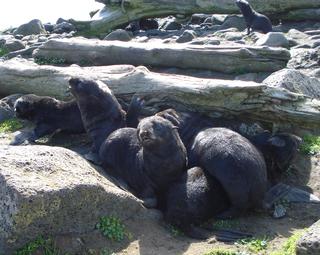Fur Seal Numbers Boom on Aleutians' Remote Bogoslof Island

Thursday, August 20 2015
Northern fur seals have been declining for decades in their stronghold on St. Paul Island in Alaska’s Pribilof Islands, but their numbers are taking off on Bogoslof Island, a couple hundred miles to the south.
A team of scientists with the National Marine Fisheries Service has been camped out on isolated, mile-long Bogoslof, just north of the Aleutian chain, trying to piece together why.
Part of the Alaska Maritime National Wildlife Refuge, Bogoslof is the top of a 6,000-foot volcanic cone about 50 miles west of Dutch Harbor. Only the top 300 feet of the cone rise above the Bering Sea.
“We first saw breeding animals there in the 80s,” Mike Williams with the National Marine Fisheries Service said. “Now we’re looking at a large portion of the Alaska population is on Bogoslof, where there weren’t any in the 80s.”
For centuries, most of the world population of northern fur seals has bred in the Pribilof Islands. Russian navigator Gavriil Pribylov even located the then-uninhabited islands in 1786 by following the barks of fur seals through the fog.
Commercial hunting of fur seals stopped in the 1980s, but the big St. Paul population has continued falling.
“We’re concerned about the decline, so we want to keep track of what’s happening with this increasing population versus the populations in the Pribilofs and be able to at least have some idea of how their populations are moving,” Williams said.
Williams said why the Bogoslof population is increasing is “the million-dollar question. “I wish we knew.”
A half million or more fur seals haul out onto the Pribilofs each summer. Many of them head down into the Aleutians other times of the year.
Scientist Bruce Wright with the Aleutian-Pribilof Islands Association, the federally recognized tribal organization of the Aleut people, said nobody knows why the Pribilof populations keep plummeting.
Only a small subsistence harvest of about 2,000 animals a year is taken. Wright said declining populations have made getting food harder in the Pribilofs.
“People out there have less access to that marine mammal, which they use for a food resource, so they’re suffering from that,” Wright said.
Scientists have lots of educated guesses but few answers about the decline – from the impacts of fisheries to climate change.
Toxic food to blame?
Wright has a hypothesis of his own: toxic food.
Blooms of harmful algae can cover the ocean in a living layer full of toxic muck. This year has one of the largest harmful algae blooms on record in the North Pacific. It reaches all the way to the Aleutians. At least two different toxins have turned up in unusually high amounts this year: domoic acid and the toxin that causes paralytic shellfish poisoning.
The small fish that fur seals eat, like sand lance, can accumulate toxins from the algae. Wright said he wants to know if the Pribilof seals have been getting doses of poison when they feed in the Aleutians.
“But now we have this population off Bogoslof, in the Aleutian Islands, and I’m really interested to find out where those fur seals are feeding,” Wright said. “If they’re feeding in the Aleutian Islands, then that would help reject this hypothesis. But maybe they’re feeding out on the continental shelf of the Bering Sea and they’re not at risk, at least right now, of encountering toxic sand lance.”
Algae grow faster when the ocean is warmer. With warming ocean temperatures, it’s only a matter of time before we see big algae blooms in the Bering Sea and Arctic Ocean like we’ve seen in the North Pacific this year, according to Wright.
The NMFS fur seal researchers on Bogoslof are counting pups and females and putting satellite tags on a few of them to see where Bogoslof seals get their meals.



